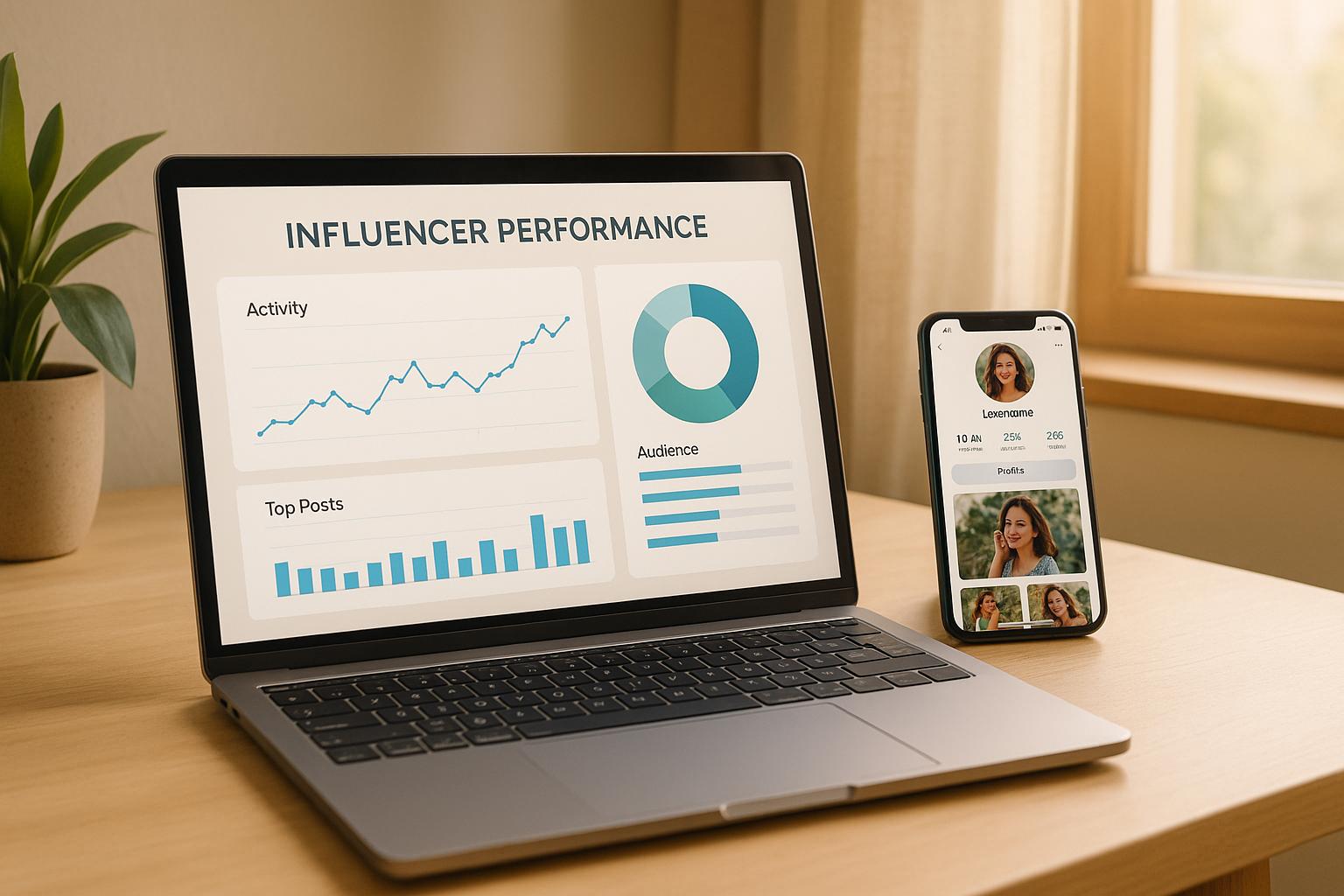Influencer marketing is no longer about surface-level metrics like follower counts. Today, success hinges on detailed data: engagement rates, conversion tracking, audience quality, and ROI. That’s where performance tracking tools come in. These tools help brands analyze campaigns, detect fake followers, measure real engagement, and tie influencer efforts to revenue. Choosing the right tool depends on your goals – whether you need fraud detection, sentiment analysis, or e-commerce integration.
Here’s a quick overview of the top tools discussed:
- HypeAuditor: Specializes in detecting fake followers and engagement.
- Brand24: Tracks social mentions and analyzes sentiment.
- Social Blade: Provides simple, real-time analytics for small businesses.
- Grin: Links influencer campaigns to e-commerce sales.
- Creator.co: Helps manage micro-influencers and audience insights.
Quick Comparison Table:
| Tool | Key Features | Pricing (USD) | Best For |
|---|---|---|---|
| HypeAuditor | Fraud detection, audience analysis | Varies | Authenticity-focused campaigns |
| Brand24 | Sentiment analysis, social monitoring | $199+/month | Reputation management |
| Social Blade | Basic analytics, historical data | $3.99+/month | Small businesses |
| Grin | E-commerce integration, ROI tracking | $999+/month | E-commerce brands |
| Creator.co | Micro-influencer management, audience insights | Varies | Micro-influencer campaigns |
These tools empower brands to make smarter decisions, track the metrics that matter, and optimize influencer partnerships. Start with a free trial or demo to find the best fit for your needs.
Best Tools for Influencer Performance Tracking
Here’s a breakdown of platforms designed to provide detailed insights into influencer performance, helping brands make data-driven decisions.
Interactive Marketing
Interactive Marketing stands out by offering actionable insights rather than just surface-level metrics. It dives into key areas like conversion tracking, audience analysis, and ROI measurement – essential for evaluating influencer success. The platform also provides educational resources on web analytics and social media engagement strategies, helping businesses distinguish between vanity metrics and meaningful indicators. This empowers marketers to understand how influencer content drives traffic and conversions across various channels.
HypeAuditor
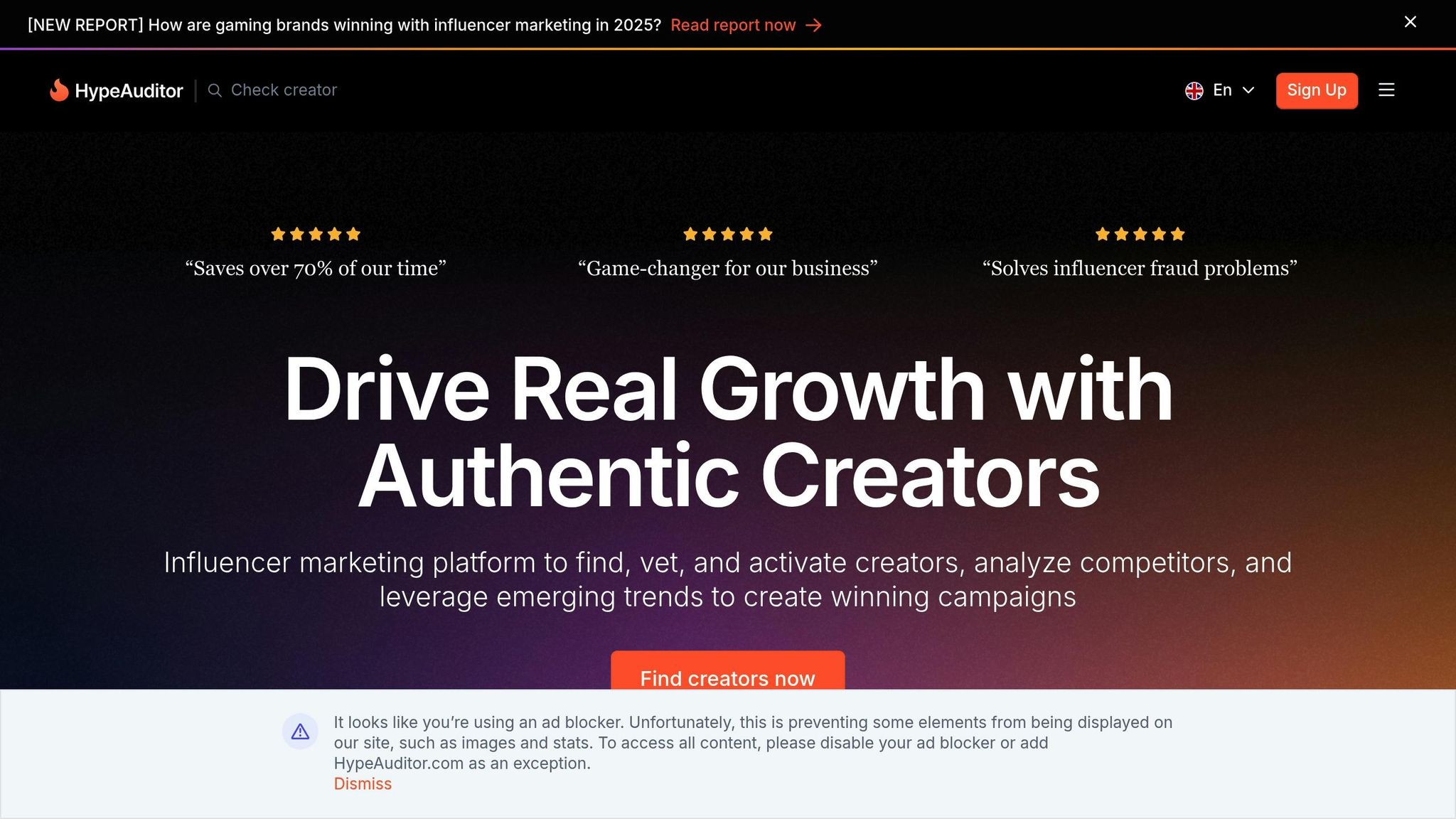
HypeAuditor is a go-to tool for brands focused on audience authenticity and fraud detection. It excels at identifying fake followers and engagement, providing detailed analytics on follower quality, engagement authenticity, and growth trends. One of its standout features is its ability to flag suspicious activity patterns, ensuring that campaign budgets are spent wisely.
With automated reporting, HypeAuditor simplifies the analysis process, delivering comprehensive breakdowns of campaign performance across multiple metrics. While its pricing is on the higher side, the tool’s advanced fraud detection capabilities make it a worthwhile investment for brands aiming to maximize campaign effectiveness.
Brand24
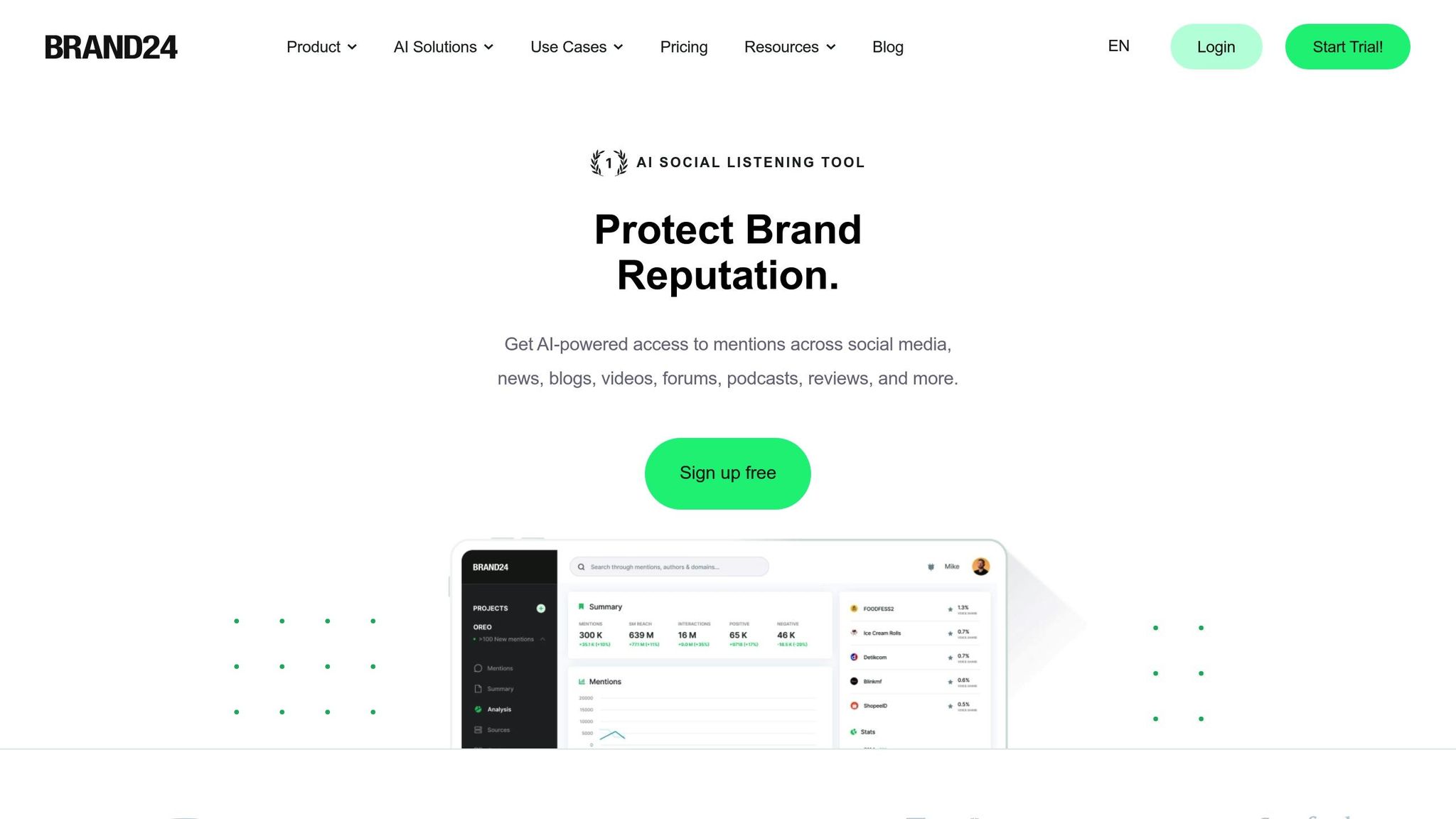
Brand24 specializes in monitoring social mentions and analyzing sentiment to measure campaign impact. Starting at $199 per month, it tracks mentions across platforms like Facebook, Instagram, LinkedIn, and TikTok. Its sentiment analysis feature goes beyond just measuring engagement volume, offering insights into the context and tone of audience reactions – critical for understanding campaign effectiveness and addressing potential issues early.
The platform also helps brands discover new influencer partnerships by tracking mentions of their products or competitors. With a free trial and a free version available, Brand24 is accessible for smaller businesses experimenting with influencer marketing strategies.
Social Blade
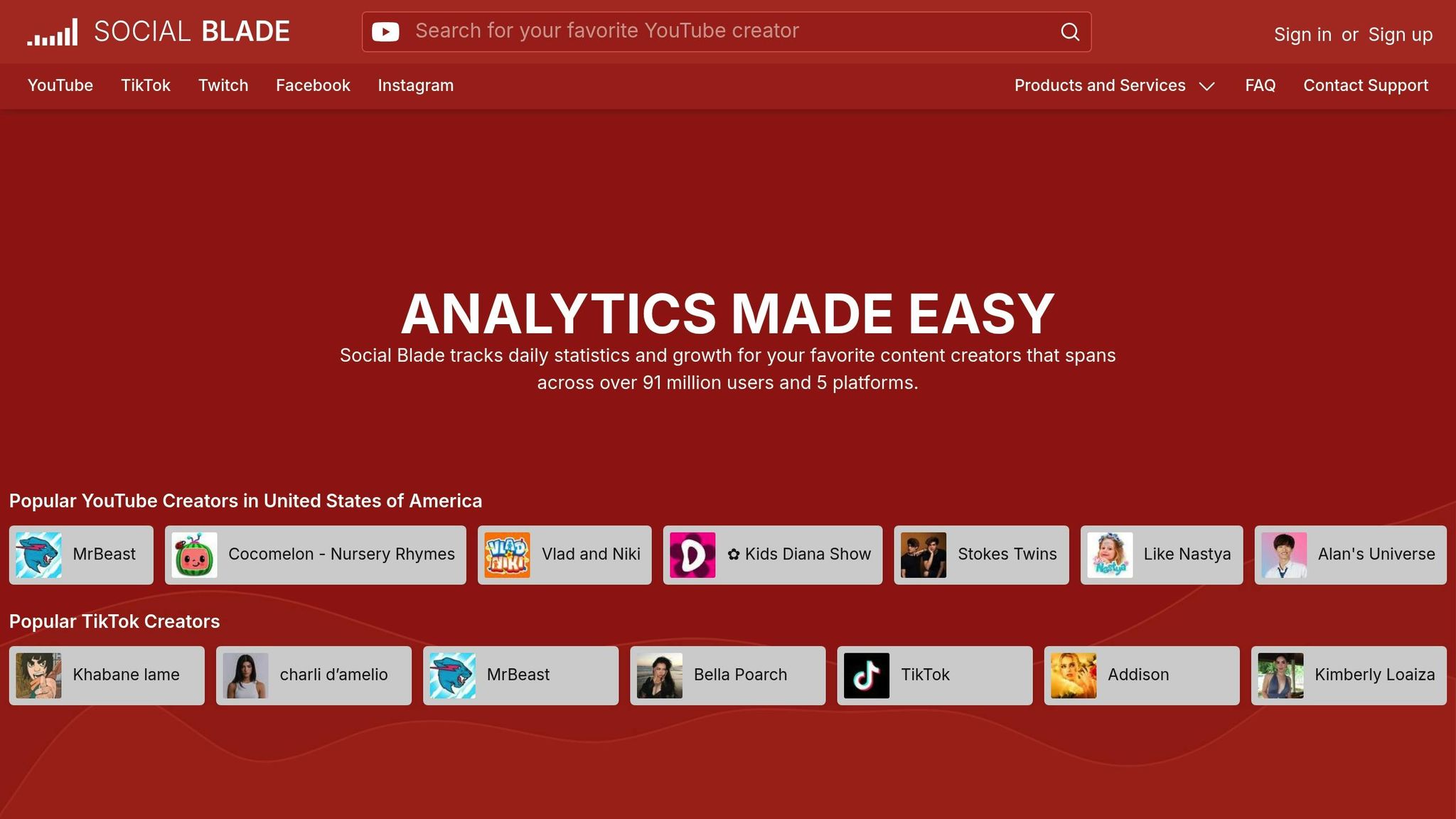
Social Blade offers real-time analytics across platforms like YouTube, Instagram, and TikTok, with plans starting at just $3.99 per month. It’s particularly useful for tracking audience growth over time and spotting unusual spikes in followers or engagement.
Known for its simplicity, Social Blade is a great starting point for small businesses looking to vet influencers. While the free version provides basic analytics, paid tiers unlock advanced features such as enhanced reporting and bulk data exports.
Grin
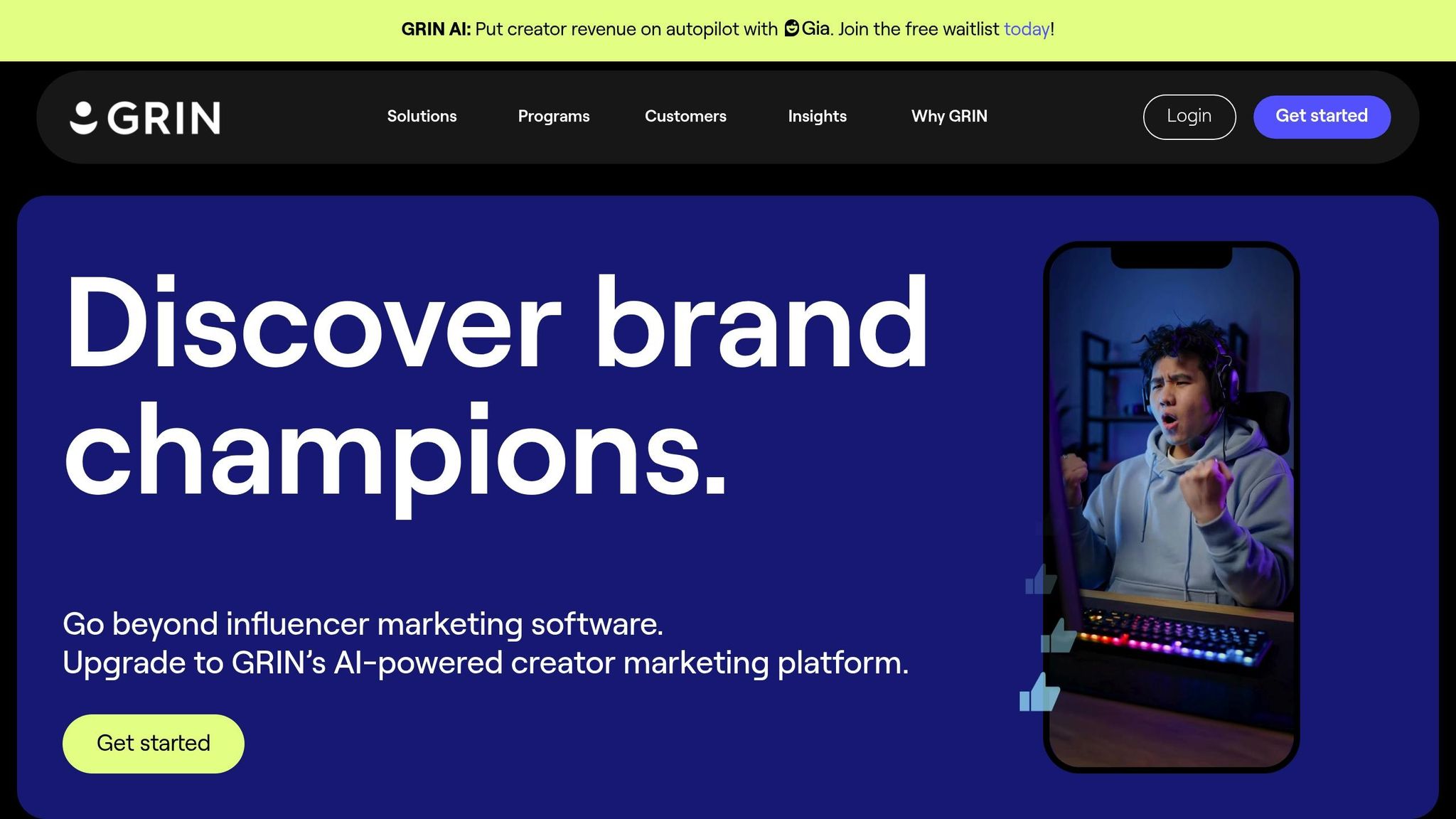
Grin is designed for brands that need to link influencer content directly to sales data. Starting at $999 per month, it integrates campaign management with e-commerce platforms like Shopify, making it ideal for businesses focused on ROI.
The platform’s standout feature is its ability to attribute revenue to specific influencer partnerships, offering clear insights into the effectiveness of campaigns. Grin also handles every stage of campaign management, from outreach to reporting. With tiered plans like Essentials, Elevate, and Enterprise, it can scale to meet the needs of growing influencer programs. However, it does not offer a free trial or free version.
Creator.co
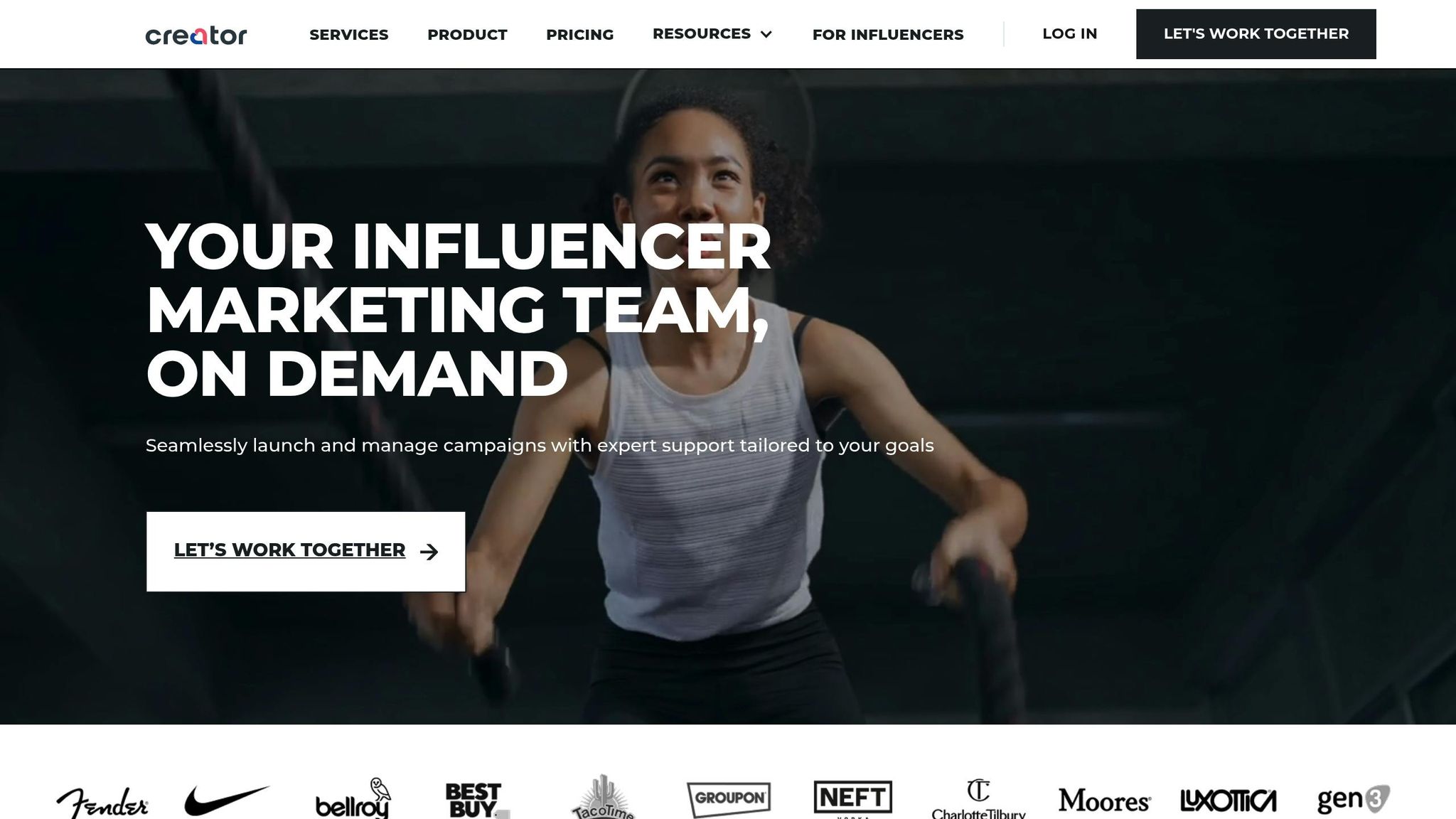
Creator.co shines in managing micro-influencers and fostering authentic audience engagement. It provides detailed demographic insights, helping brands partner with influencers whose audiences align with their target markets.
The platform’s reporting tools analyze audience overlap, optimal posting times, and content performance, giving brands the data they need to fine-tune their influencer strategies. This makes it a powerful tool for optimizing campaign timing and refining influencer selection for better results.
Tool Comparison Table
Table Format
Here’s a quick glance at the key features and pricing of the tools we’ve discussed, designed to help you make an informed choice for your marketing efforts.
| Tool | Supported Platforms | Pricing (USD) | Key Features | Best Use Cases |
|---|---|---|---|---|
| HypeAuditor | Instagram, YouTube, TikTok, Twitter | Varies | Deep audience analysis and performance metrics | Brands targeting authentic influencer engagement |
| Brand24 | Facebook, Instagram, LinkedIn, TikTok | Varies | Social monitoring and sentiment analysis | Companies focused on brand reputation management |
| Social Blade | YouTube, Instagram, TikTok, Twitter | Varies | Simple analytics with historical performance data | Small businesses/startups needing basic insights |
| Grin | Multi-platform with e-commerce integration | Varies | Influencer campaign management with e-commerce tools | E-commerce brands needing end-to-end tracking |
| Creator.co | Multi-platform | Varies | Micro-influencer management and audience insights | Brands prioritizing authentic micro-influencer campaigns |
This table brings together the standout features and ideal use cases for each tool, helping you identify the best fit for your marketing strategy. Whether you’re after detailed analytics or micro-influencer management, there’s a tool here to match your needs.
How to Choose the Right Tool
When you’re picking an influencer performance tracking tool, make sure it works well with the systems you already use – like your CRM, social analytics, and marketing platforms. Check for features that make integration easy, such as built-in tools, APIs, or webhooks. These can help bring all your data together and avoid any disconnects in communication.
It’s also important to think through the true cost. Don’t just focus on the subscription fee – factor in other expenses like setup, training, data migration, and any ongoing costs tied to keeping the tool integrated with your systems.
Conclusion
Keeping tabs on influencer performance is a must if you want to make smart marketing decisions and see real results from your campaigns. The tools we’ve discussed each offer something unique – whether it’s educational insights from Interactive Marketing or platforms that dive deep into engagement and audience demographics. These tools are all about helping you make informed, data-backed decisions.
The key is finding the right fit for your workflow. Look for a tool that brings together data from multiple platforms and focuses on the metrics that matter most to you – whether it’s reach, engagement, conversions, or ROI. Remember, the best tool is the one you’ll actually use. A straightforward dashboard that delivers the insights you need can often be more effective than a complex system with features you’ll never touch.
Start by pinpointing the metrics that are most important for your goals. Then, experiment with a few tools designed to track those areas. Many platforms offer free trials, so you can test them out before making a commitment.
Success in influencer marketing comes down to making decisions based on solid data. The right tracking tool is your ally in this process, giving you the insights you need to fine-tune your campaigns and get the most out of your marketing budget. Take the time to choose wisely, and you’ll set yourself up for better results.
FAQs
What’s the best way to choose an influencer performance tracking tool that fits my brand’s goals?
Choosing an influencer performance tracking tool starts with pinpointing your brand’s specific goals. Are you aiming to measure content performance, track audience engagement, or dive into follower demographics? Each tool has its strengths, so having a clear focus will guide your decision.
Once your goals are set, take a close look at the features each tool offers. Prioritize options like in-depth analytics, automation capabilities, and influencer discovery tools to ensure they match your requirements. Don’t forget to factor in practical considerations like your budget, how user-friendly the platform is, and whether it integrates seamlessly with your existing systems. Finding a tool that strikes the right balance between functionality and cost can maximize your results and make the investment worthwhile.
What should I consider when choosing an influencer performance tracking tool that works with my current marketing systems?
When choosing a tool to track influencer performance, make sure it works well with your current platforms and supports your data formats. This ensures smooth data sharing and keeps your workflows running without interruptions.
Key features to consider include automating repetitive tasks, tracking detailed metrics like engagement, reach, and conversions, and offering real-time reporting to fine-tune campaigns effectively. Also, it’s important to pick a tool that prioritizes data security and adheres to privacy regulations to safeguard sensitive information and maintain trust.
How do influencer tracking tools measure ROI and link revenue to individual influencers?
Influencer tracking tools help measure ROI by focusing on key metrics like engagement rates, conversion rates, and return on ad spend (ROAS). These metrics provide clear insights into how well a campaign is performing and how profitable it is.
Many of these tools also allow you to pinpoint revenue generated by specific influencers. They do this by tracking sales through unique links, promo codes, or tagged campaigns. This makes it simpler to evaluate each influencer’s impact and, if needed, adopt performance-based compensation strategies.

